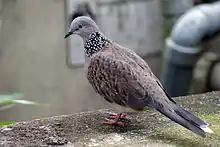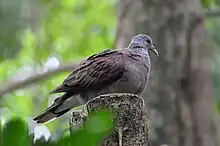Streptopelia
Streptopelia is a genus of birds in the pigeon and dove family Columbidae. These are mainly slim, small to medium-sized species. The upperparts tend to be pale brown and the underparts are often a shade of pink. Many have a characteristic black-and-white patch on the neck and monotonous cooing songs.
| Streptopelia | |
|---|---|
 | |
| The Eurasian collared dove (Streptopelia decaocto) is a typical and widespread member of the collared doves | |
| Scientific classification | |
| Domain: | Eukaryota |
| Kingdom: | Animalia |
| Phylum: | Chordata |
| Clade: | Dinosauria |
| Class: | Aves |
| Order: | Columbiformes |
| Family: | Columbidae |
| Subfamily: | Columbinae |
| Genus: | Streptopelia Bonaparte, 1855 |
| Type species | |
| Columba turtur | |
| Species | |
|
See text | |
The heartland of this genus is Africa, but several species occur in tropical South Asia. As a group, this genus is highly successful; many species are abundant in a range of habitats in the tropics and two now have a much more extensive distribution. The Eurasian collared dove (Streptopelia decaocto) naturally expanded out of its original range of the warmer temperate regions from southeastern Europe to Japan to colonise the rest of Europe, reaching as far west as Great Britain by 1960 and Ireland soon after. It has also been introduced into the U.S. and, as of 1999, it had been reported from 22 states and was still spreading rapidly.
Taxonomy
The genus Streptopelia was introduced in 1855 by the French ornithologist Charles Lucien Bonaparte.[1] The name is from the Ancient Greek στρεπτός (streptós) – literal meaning "twisted" but, by extension, "wearing a torc" (i.e., twisted metal collar) – and πέλεια (péleia) meaning "wild dove".[2] Also in 1855, the English zoologist George Robert Gray designated the type species as Streptopelia risoria, the Barbary dove.[3][4] Although Streptopelia risoria has been confirmed as a valid name by the International Commission on Zoological Nomenclature,[5] the Barbary dove may be a domesticated form of the African collared dove (Streptopelia roseogrisea).[6]
A DNA sequence analysis has concluded that the genus consists of three distinct lineages. One contains the laughing dove and the spotted dove, which have long been recognized as having distinct morphology and behavior. The second group contains most of the other species, except for the Malagasy turtle dove and the pink pigeon, which appear to be the surviving species of an endemic Madagascar/Mascarenes radiation and have at times been placed in other genera. The two-species lineages appear to be each other's closest relatives and cannot be firmly assigned to either Columba or Streptopelia (although overall they seem to be close to the latter). Thus, it might be best to split the two minor lineages off as distinct genera, namely Spilopelia for the first (which, although not having priority over Stigmatopelia, which occurs earlier on the page,[7] is chosen on the first reviser principle) and Nesoenas for the second.[8]
Species
| ||||||||||||||||||||||||||||||||||||||||||||||||||||||||||||||||||||||||||||||||||||||||||||||||
| Phylogenetic position based on Johnson et al. (2001).[8] |


The genus contains 15 species:[9]
- European turtle dove Streptopelia turtur
- Dusky turtle dove, Streptopelia lugens
- Adamawa turtle dove, Streptopelia hypopyrrha
- Oriental turtle dove Streptopelia orientalis
- Sunda collared dove, Streptopelia bitorquata
- Philippine collared dove, Streptopelia dusumieri
- Eurasian collared dove, Streptopelia decaocto
- Burmese collared dove, Streptopelia xanthocycla[10]
- African collared dove, Streptopelia roseogrisea
- White-winged collared dove, Streptopelia reichenowi
- Mourning collared dove, Streptopelia decipiens
- Red-eyed dove, Streptopelia semitorquata
- Ring-necked dove, Streptopelia capicola
- Vinaceous dove, Streptopelia vinacea
- Red collared dove, Streptopelia tranquebarica
The genera Spilopelia and Nesoenas were formerly placed in Streptopelia, but have since been separated out to make the genus monophyletic.[8][9]
References
- Bonaparte, Charles Lucien (1855). "Coup d'oeil sur les pigeons (quatrième partie)". Comptes Rendus Hebdomadaires des Séances de l'Académie des Sciences (in French). 40: 15–24 [17].
- Jobling, James A. (2010). The Helm Dictionary of Scientific Bird Names. London: Christopher Helm. p. 367. ISBN 978-1-4081-2501-4.
- Gray, George Robert (1855). Catalogue of the Genera and Subgenera of Birds Contained in the British Museum. London: British Museum. p. 150.
- Peters, James Lee, ed. (1937). Check-list of Birds of the World. Vol. 3. Cambridge, Massachusetts: Harvard University Press. p. 88.
- ICZN (International Commission on Zoological Nomenclature) (2008). "Opinion 2215 (Case 3380), Streptopelia risoria (Linnaeus, 1758) (Aves, Columbidae): priority maintained". Bulletin of Zoological Nomenclature. 65 (4): 327–328. doi:10.21805/bzn.v65i4.a2. S2CID 82029460.
- Baptista, L.F.; Trail, P.W.; Horblit, H.M.; Boesman, P.; Garcia, E.F.J. (2020). del Hoyo, J.; Elliott, A.; Sargatal, J.; Christie, D.A.; de Juana, E. (eds.). "African Collared-dove (Streptopelia roseogrisea)". Handbook of the Birds of the World Alive. Lynx Edicions. doi:10.2173/bow.afcdov1.01. S2CID 216467812. Retrieved 16 February 2020.
- Sundevall, Carl (1872). Methodi naturalis avium disponendarum tentamen. Försök till fogelklassens naturenliga uppställnung. Stockholm: Samson and Wallin. p. 100.
- Johnson, K.P.; De Kort, S.; Dinwoodey, K.; Mateman, A.C.; Ten Cate, C.; Lessells, C.M.; Clayton, D.H. (2001). "A molecular phylogeny of the dove genera Streptopelia and Columba". Auk. 118 (4): 874–887. doi:10.1642/0004-8038(2001)118[0874:AMPOTD]2.0.CO;2.
- Gill, Frank; Donsker, David; Rasmussen, Pamela, eds. (2020). "Pigeons". IOC World Bird List Version 10.1. International Ornithologists' Union. Retrieved 27 February 2020.
- "Species Updates – IOC World Bird List". Retrieved 2021-06-18.